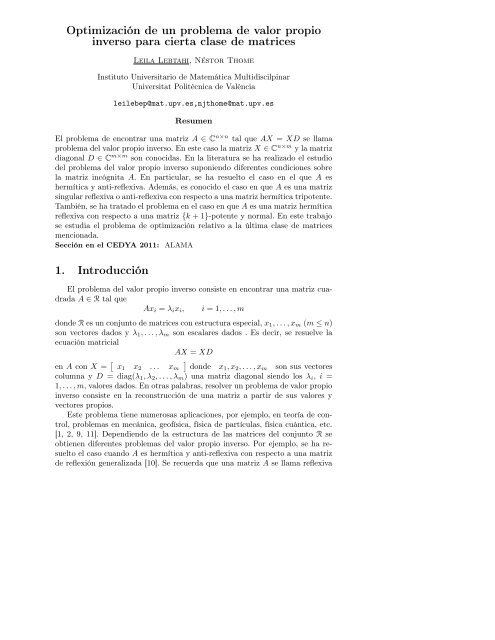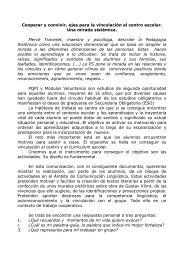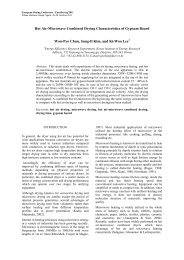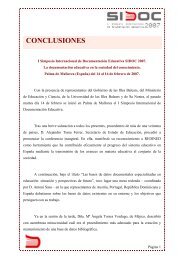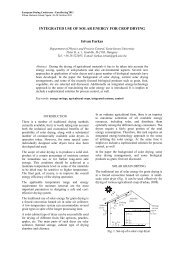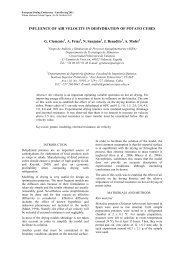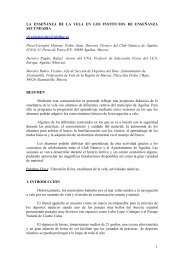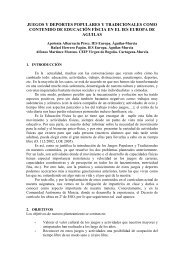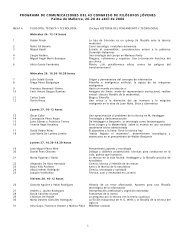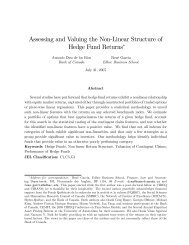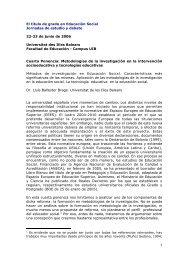Optimización de un problema de valor propio inverso ... - UIB Congres
Optimización de un problema de valor propio inverso ... - UIB Congres
Optimización de un problema de valor propio inverso ... - UIB Congres
You also want an ePaper? Increase the reach of your titles
YUMPU automatically turns print PDFs into web optimized ePapers that Google loves.
Optimización <strong>de</strong> <strong>un</strong> <strong>problema</strong> <strong>de</strong> <strong>valor</strong> <strong>propio</strong><br />
<strong>inverso</strong> para cierta clase <strong>de</strong> matrices<br />
Leila Lebtahi, Néstor Thome<br />
Instituto Universitario <strong>de</strong> Matemática Multidiscilpinar<br />
Universitat Politècnica <strong>de</strong> València<br />
leilebep@mat.upv.es,njthome@mat.upv.es<br />
Resumen<br />
El <strong>problema</strong> <strong>de</strong> encontrar <strong>un</strong>a matriz A ∈ C n×n tal que AX = XD se llama<br />
<strong>problema</strong> <strong>de</strong>l <strong>valor</strong> <strong>propio</strong> <strong>inverso</strong>. En este caso la matriz X ∈ C n×m y la matriz<br />
diagonal D ∈ C m×m son conocidas. En la literatura se ha realizado el estudio<br />
<strong>de</strong>l <strong>problema</strong> <strong>de</strong>l <strong>valor</strong> <strong>propio</strong> <strong>inverso</strong> suponiendo diferentes condiciones sobre<br />
la matriz incógnita A. En particular, se ha resuelto el caso en el que A es<br />
hermítica y anti-reflexiva. A<strong>de</strong>más, es conocido el caso en que A es <strong>un</strong>a matriz<br />
singular reflexiva o anti-reflexiva con respecto a <strong>un</strong>a matriz hermítica tripotente.<br />
También, se ha tratado el <strong>problema</strong> en el caso en que A es <strong>un</strong>a matriz hermítica<br />
reflexiva con respecto a <strong>un</strong>a matriz {k + 1}-potente y normal. En este trabajo<br />
se estudia el <strong>problema</strong> <strong>de</strong> optimización relativo a la última clase <strong>de</strong> matrices<br />
mencionada.<br />
Sección en el CEDYA 2011: ALAMA<br />
1. Introducción<br />
El <strong>problema</strong> <strong>de</strong>l <strong>valor</strong> <strong>propio</strong> <strong>inverso</strong> consiste en encontrar <strong>un</strong>a matriz cuadrada<br />
A ∈ R tal que<br />
Ax i = λ i x i , i = 1, . . . , m<br />
don<strong>de</strong> R es <strong>un</strong> conj<strong>un</strong>to <strong>de</strong> matrices con estructura especial, x 1 , . . . , x m (m ≤ n)<br />
son vectores dados y λ 1 , . . . , λ m son escalares dados . Es <strong>de</strong>cir, se resuelve la<br />
ecuación matricial<br />
AX = XD<br />
en A con X = [ x 1 x 2 . . . x m<br />
]<br />
don<strong>de</strong> x1 , x 2 , . . . , x m son sus vectores<br />
columna y D = diag(λ 1 , λ 2 , . . . , λ m ) <strong>un</strong>a matriz diagonal siendo los λ i , i =<br />
1, . . . , m, <strong>valor</strong>es dados. En otras palabras, resolver <strong>un</strong> <strong>problema</strong> <strong>de</strong> <strong>valor</strong> <strong>propio</strong><br />
<strong>inverso</strong> consiste en la reconstrucción <strong>de</strong> <strong>un</strong>a matriz a partir <strong>de</strong> sus <strong>valor</strong>es y<br />
vectores <strong>propio</strong>s.<br />
Este <strong>problema</strong> tiene numerosas aplicaciones, por ejemplo, en teoría <strong>de</strong> control,<br />
<strong>problema</strong>s en mecánica, geofísica, física <strong>de</strong> partículas, física cuántica, etc.<br />
[1, 2, 9, 11]. Dependiendo <strong>de</strong> la estructura <strong>de</strong> las matrices <strong>de</strong>l conj<strong>un</strong>to R se<br />
obtienen diferentes <strong>problema</strong>s <strong>de</strong>l <strong>valor</strong> <strong>propio</strong> <strong>inverso</strong>. Por ejemplo, se ha resuelto<br />
el caso cuando A es hermítica y anti-reflexiva con respecto a <strong>un</strong>a matriz<br />
<strong>de</strong> reflexión generalizada [10]. Se recuerda que <strong>un</strong>a matriz A se llama reflexiva
con respecto a <strong>un</strong>a matriz J cuando A = JAJ y anti-reflexiva con respecto a<br />
J cuando A = −JAJ. A<strong>de</strong>más, <strong>un</strong>a matriz J se llama reflexión generalizada<br />
si J 2 = I y J ∗ = J. Por otra parte, en [4], se resuelve <strong>un</strong> <strong>problema</strong> <strong>de</strong> mínimos<br />
cuadrados usando diferentes propieda<strong>de</strong>s <strong>de</strong> <strong>un</strong>a nueva clase <strong>de</strong> matrices<br />
introducidas por los autores: las matrices reflexivas con respecto a <strong>un</strong> par <strong>de</strong><br />
matrices que sean ambas reflexiones generalizadas. También, en [6], se analizan<br />
las situaciones en que la matriz A sea hermítica bajo las condiciones adicionales<br />
<strong>de</strong> ser reflexiva o anti-reflexiva con respecto a <strong>un</strong>a matriz J tripotente y hermítica.<br />
El <strong>problema</strong> <strong>de</strong> <strong>valor</strong> <strong>propio</strong> <strong>inverso</strong> generalizado para el caso <strong>de</strong> matrices<br />
K-centro hermíticas, don<strong>de</strong> K es <strong>un</strong>a matriz <strong>de</strong> permutación, ha sido resuelto<br />
en [8]. A<strong>de</strong>más <strong>de</strong> encontrar las matrices A especificadas en cada <strong>un</strong>o <strong>de</strong> los<br />
<strong>problema</strong>s anteriores, también es posible resolver el <strong>problema</strong> <strong>de</strong> minimización<br />
asociado. Por otra parte, en [7], se ha tratado el <strong>problema</strong> en el caso en que A<br />
es <strong>un</strong>a matriz hermítica reflexiva con respecto a <strong>un</strong>a matriz {k + 1}-potente y<br />
normal.<br />
Se <strong>de</strong>notará por C m×n el conj<strong>un</strong>to <strong>de</strong> las matrices complejas <strong>de</strong> tamaño<br />
m × n, por R m×n el conj<strong>un</strong>to <strong>de</strong> las matrices reales <strong>de</strong> tamaño m × n y por<br />
H n×n el <strong>de</strong> las matrices hermíticas <strong>de</strong> tamaño n × n. A<strong>de</strong>más, con I n se <strong>de</strong>signará<br />
la matriz i<strong>de</strong>ntidad <strong>de</strong> tamaño n. Se <strong>de</strong>fine el producto escalar en C m×n<br />
por<br />
〈A, B〉 = traza (B ∗ A) , ∀A, B ∈ C m×n ,<br />
don<strong>de</strong> A ∗ y ‖A‖ F<br />
<strong>de</strong>notan la traspuesta conjugada y la norma <strong>de</strong> Frobenius <strong>de</strong><br />
la matriz A, respectivamente.<br />
Se recuerda que para <strong>un</strong>a matriz M ∈ C m×n dada, su inversa <strong>de</strong> Moore-<br />
Penrose es la única matriz M † que satisface MM † M = M, M † MM † = M † ,<br />
(MM † ) ∗ = MM † y (M † M) ∗ = M † M. Esta inversa generalizada siempre<br />
existe y está <strong>un</strong>ívocamente <strong>de</strong>terminada [3]. Se utilizará la siguiente notación:<br />
W (l) (M) = I − M † M y W (r) (M) = I − MM † . Si la matriz M sólo satisface la<br />
ecuación MM − M = M se dice que M − es <strong>un</strong>a {1}-inversa generalizada <strong>de</strong> M.<br />
En este caso también se notará: W (l) (M) = I −M − M y W (r) (M) = I −MM − .<br />
De ahora en a<strong>de</strong>lante se consi<strong>de</strong>rará <strong>un</strong>a matriz J ∈ C n×n que sea normal y<br />
{k + 1}-potente (es <strong>de</strong>cir, JJ ∗ = J ∗ J y J k+1 = J, k ∈ N).<br />
Definición 1. Se dice que <strong>un</strong>a matriz A ∈ H n×n es reflexiva con respecto a la<br />
matriz J si A = JAJ. El conj<strong>un</strong>to <strong>de</strong> todas las matrices hermíticas reflexivas<br />
con respecto a J se <strong>de</strong>notará por HJ n×n .<br />
De la <strong>de</strong>finición anterior se <strong>de</strong>duce que los <strong>valor</strong>es <strong>propio</strong>s <strong>de</strong> <strong>un</strong>a matriz<br />
hermítica y reflexiva con respecto a la matriz normal y {k + 1}-potente J son<br />
reales.<br />
Sea X = [ x 1 . . . x m<br />
]<br />
∈ C n×m y D = diag(λ 1 , . . . , λ m ) ∈ R m×m los<br />
vectores y <strong>valor</strong>es <strong>propio</strong>s dados. Entonces el <strong>problema</strong> <strong>de</strong>l <strong>valor</strong> <strong>propio</strong> <strong>inverso</strong><br />
asociado es el siguiente:<br />
(I) Encontrar todas las matrices A ∈ HJ n×n tales que AX = XD [7].<br />
Sea S el conj<strong>un</strong>to solución <strong>de</strong>l <strong>problema</strong> (I). En este trabajo se consi<strong>de</strong>ra el<br />
<strong>problema</strong> <strong>de</strong> minimización siguiente:
(II) Dada <strong>un</strong>a matriz Ä ∈ Cn×n , encontrar  ∈ S tal que<br />
mín<br />
A∈S ‖A − Ä‖ F = ‖Â − Ä‖ F<br />
Este trabajo esta organizado <strong>de</strong> la forma siguiente. En la Sección 2, se da la<br />
estructura <strong>de</strong>l conj<strong>un</strong>to HJ n×n presentando las condiciones <strong>de</strong> existencia <strong>de</strong> las<br />
soluciones <strong>de</strong>l <strong>problema</strong> mencionado en (I) y la forma explícita <strong>de</strong> sus soluciones.<br />
En la Sección 3, primero se muestra la existencia y <strong>un</strong>icidad <strong>de</strong> la solución <strong>de</strong>l<br />
<strong>problema</strong> presentado en (II), y luego se encuentra la expresión <strong>de</strong> dicha solución<br />
cuando el conj<strong>un</strong>to S es no vacío.<br />
2. Existencia y forma explícita <strong>de</strong> las soluciones<br />
<strong>de</strong>l <strong>problema</strong> (I)<br />
Primero se analiza la matriz normal y {k + 1}-potente J para dar la estructura<br />
<strong>de</strong>l conj<strong>un</strong>to HJ n×n . Como la matriz J es normal, es diagonalizable<br />
mediante <strong>un</strong>a matriz <strong>un</strong>itaria y, como J k+1 = J, el espectro <strong>de</strong> J que se <strong>de</strong>notará<br />
por {ω 1 , ω 2 , . . . , ω t } está incluido en {0} ∪ Ω k , siendo Ω k el conj<strong>un</strong>to <strong>de</strong><br />
todas las raíces <strong>de</strong> la <strong>un</strong>idad <strong>de</strong> or<strong>de</strong>n k. Entonces, existe <strong>un</strong>a matriz <strong>un</strong>itaria<br />
U ∈ C n×n tal que<br />
J = U diag(ω 1 I r1 , . . . , ω t I rt , O rt+1 ) U ∗ (1)<br />
siendo r 1 + · · · + r t = rango(J) y r 1 + · · · + r t + r t+1 = n.<br />
Sea A ∈ HJ n×n . Se particiona la matriz U ∗ AU en bloques <strong>de</strong> tamaños<br />
a<strong>de</strong>cuados como sigue:<br />
⎡<br />
⎤<br />
A 1,1 . . . A 1,t A 1,t+1<br />
U ∗ .<br />
AU = ⎢ . ..<br />
. ..<br />
. ..<br />
⎥<br />
(2)<br />
⎣ A t,1 . . . A t,t A t,t+1<br />
⎦<br />
A t+1,1 . . . A t+1,t A t+1,t+1<br />
<strong>de</strong> acuerdo con los bloques <strong>de</strong> la partición <strong>de</strong> J. De (1) y (2), la igualdad<br />
A = JAJ lleva a<br />
⎧⎨<br />
⎩<br />
A t+1,j = O para j ∈ {1, . . . , t + 1}<br />
A j,t+1 = O para j ∈ {1, . . . , t}<br />
A i,j = ω i ω j A i,j para i, j ∈ {1, . . . , t}<br />
De aquí resulta que ω i ω j = 1 o bien A i,j = O con i, j ∈ {1, . . . , t}. Esto implica<br />
que para cada i, j ∈ {1, . . . , t} o bien ω i = ω j o bien los bloques A i,j y A j,i son<br />
simultáneamente nulos. Se observa que la forma <strong>de</strong> la matriz U ∗ AU <strong>de</strong>pen<strong>de</strong> <strong>de</strong><br />
las raíces <strong>de</strong> la <strong>un</strong>idad. Si a<strong>de</strong>más se consi<strong>de</strong>ra que en la factorización <strong>de</strong> J el<br />
or<strong>de</strong>n <strong>de</strong> los <strong>valor</strong>es <strong>propio</strong>s en la matriz U ∗ JU es 1, −1, ω 3 , ω 3 , . . . , ω p−1 , ω p−1 , 0<br />
(en caso que aparezcan 1 y −1), entonces la matriz A tiene la forma<br />
A = U diag(A 1,1 , A 2,2 , Ã3,4, . . . , Ãp−1,p, O) U ∗ (3)
don<strong>de</strong>, tomando p <strong>de</strong> manera a<strong>de</strong>cuada, se tiene que<br />
[<br />
]<br />
O A<br />
à s,s+1 =<br />
s,s+1<br />
siendo s ∈ {3, 5, . . . , p − 1}. (4)<br />
O<br />
A s+1,s<br />
En relación a (3), se asocia el bloque A 1,1 al <strong>valor</strong> <strong>propio</strong> 1 y el bloque A 2,2<br />
al <strong>valor</strong> <strong>propio</strong> −1 (si figuran en J). También, en relación a (4), cada bloque<br />
à s,s+1 está asociado a los <strong>valor</strong>es <strong>propio</strong>s ω s y ω s .<br />
La forma explícita <strong>de</strong> la solución <strong>de</strong>l <strong>problema</strong> (I) viene dada en el siguiente<br />
resultado.<br />
Teorema 1. Sean X ∈ C n×m , D ∈ R m×m <strong>un</strong>a matriz diagonal y J ∈ C n×n<br />
<strong>un</strong>a matriz normal {k + 1}-potente como en (1). Sea la partición (<strong>de</strong> tamaños<br />
apropiados)<br />
X = U [ X T 1 X T 2<br />
˜X T 3<br />
˜X T 5 . . . ˜XT p−1 X T p+1<br />
] T<br />
(5)<br />
con ˜XT s = [ ]<br />
Xs T Xs+1<br />
T , s ∈ {3, 5, . . . , p − 1}. Entonces existe <strong>un</strong>a matriz<br />
A ∈ HJ n×n tal que AX = XD si y sólo si existen matrices {1}-inversas<br />
generalizadas X − i <strong>de</strong> X i tales que X i DW (l) (X i ) = O y<br />
X i DX − i − (X − i )∗ DX ∗ i = (Y i W (r) (X i )) ∗ − Y i W (r) (X i ) para i = 1, 2; (6)<br />
a<strong>de</strong>más existen matrices {1}-inversas generalizadas X − s <strong>de</strong> X s , s = 3, 4, . . . , p,<br />
tales que <strong>de</strong>be ser<br />
X s DW (l) (X s+1 ) = O, W (r) (X ∗ s )DX ∗ s+1 = O, X ∗ s X s D = DX ∗ s+1X s+1 (7)<br />
para s ∈ {3, 5, . . . , p − 1} y también X p+1 D = O. En este caso, con la misma<br />
notación <strong>de</strong> (4), la solución general viene dada por<br />
(<br />
)<br />
A = U diag A 1,1 , A 2,2 , Ã3,4, . . . , Ãp−1,p, O U ∗ (8)<br />
don<strong>de</strong><br />
A i,i = X i DX − i + Y i W (r) (X i ), i = 1, 2, (9)<br />
A s,s+1 = (X s ∗ ) − DX ∗ s+1+W (l) (X s ∗ )X s DX − s+1 +W (l) (X s ∗ )Y s W (r) (X s+1 ) (10)<br />
A ∗ s+1,s = A s,s+1 , para s ∈ {3, 5, . . . , p − 1} e Y 1 , Y 2 , Y s , s = 3, 5, . . . , p − 1, son<br />
matrices arbitrarias <strong>de</strong> tamaños a<strong>de</strong>cuados.<br />
3. La solución <strong>de</strong>l <strong>problema</strong> (II)<br />
En esta sección se va a resolver el <strong>problema</strong> (II). Usando el Teorema 1 cuando<br />
el conj<strong>un</strong>to S <strong>de</strong> soluciones <strong>de</strong>l <strong>problema</strong> (I) es no vacío, es fácil comprobar<br />
que S es <strong>un</strong> conj<strong>un</strong>to cerrado convexo. A<strong>de</strong>más, como C n×n es <strong>un</strong> espacio <strong>de</strong><br />
Banach <strong>un</strong>iformemente convexo con respecto a la norma <strong>de</strong> Frobenius, existe<br />
<strong>un</strong>a única solución al <strong>problema</strong> (II) ([5], p. 22). Para encontrar esta solución<br />
única necesitaremos los dos resultados siguientes.
Lema 1. Sean M ∈ C n×m y R ∈ C r×n . Entonces existe Ŷ ∈ Cr×n tal que<br />
mín<br />
Y ∈C r×n ‖Y ( I n − MM †) − R‖ F = ‖Ŷ (I n − MM † ) − R‖ F (11)<br />
don<strong>de</strong> Ŷ = R + GM † para <strong>un</strong>a matriz arbitraria G ∈ C r×m .<br />
Demostración. Usando propieda<strong>de</strong>s <strong>de</strong> la inversa generalizada <strong>de</strong> Moore-Penrose,<br />
<strong>de</strong>l producto escalar <strong>de</strong>finido en la sección 1 y <strong>de</strong> la traza <strong>de</strong> <strong>un</strong>a matriz, se tiene<br />
que<br />
‖Y (I n − MM † ) − R‖ 2 F = 〈Y (I n − MM † ) − R, Y (I n − MM † ) − R〉<br />
= 〈 (Y − R) ( I n − MM †) , (Y − R) ( I n − MM †)〉 + 〈 RMM † , RMM †〉<br />
= ‖ (Y − R) ( I n − MM †) ‖ 2 F + ‖RMM † ‖ 2 F .<br />
Entonces encontrar<br />
es equivalente a encontrar<br />
mín<br />
Y ∈C r×n ‖Y ( I n − MM †) − R‖ F<br />
mín ‖ (Y − R) ( I n − MM †) ‖ F . (12)<br />
Y ∈C r×n<br />
Ahora se tiene que (Y − R) ( I n − MM †) = O si y sólo si R(I n − MM † ) ⊆<br />
N (Y − R). Como I n − MM † es <strong>un</strong> proyector se tiene que R(I n − MM † ) =<br />
N (MM † ) = N (M † ) ya que M † MM † = M † . De aquí se tiene que N (M † ) ⊆<br />
N (Y − R) equivale a que exista <strong>un</strong>a matriz G ∈ C r×m tal que Y − R = GM † .<br />
Entonces, la solución <strong>de</strong> (11) pue<strong>de</strong> expresarse como Ŷ = R + GM † .<br />
Nota 1. Es fácil ver que ‖Ŷ ( I n − MM †) − R‖ F = ‖RMM † ‖ F . Es <strong>de</strong>cir, el<br />
<strong>valor</strong> <strong>de</strong> ‖Ŷ ( I n − MM †) − R‖ F es invariante para G.<br />
Lema 2. Sean M 1 ∈ C m×r , M 2 ∈ C n×t , R 1 ∈ C r×n y R 2 ∈ C r×n . Entonces el<br />
<strong>problema</strong> <strong>de</strong> minimización<br />
mín ‖W (l) (M 1 )Y W (r) (M 2 ) − R 1 ‖ 2<br />
Y ∈C r×n F +<br />
tiene como soluciones las matrices Ŷ ∈ Cr×n dadas por<br />
mín<br />
Y ∈C r×n ‖W (l) (M 1 )Y W (r) (M 2 ) − R 2 ‖ 2 F<br />
(13)<br />
Ŷ = 1 2 (R 1 + R 2 ) + GM 2 M † 2 + M † 1 M 1G − M † 1 M 1GM 2 M † 2<br />
don<strong>de</strong> G ∈ C r×n es <strong>un</strong>a matriz arbitraria.<br />
Demostración. Usando propieda<strong>de</strong>s <strong>de</strong> la inversa generalizada <strong>de</strong> Moore-Penrose,<br />
<strong>de</strong>l producto escalar <strong>de</strong>finido en la sección 1 y <strong>de</strong> la traza <strong>de</strong> <strong>un</strong>a matriz, se tiene
que<br />
‖(I r − M † 1 M 1)Y (I n − M 2 M † 2 ) − R 1‖ 2 F +<br />
+‖(I r − M † 1 M 1)Y (I n − M 2 M † 2 ) − R 2‖ 2 F<br />
= 2‖(I r − M † 1 M 1)Y (I n − M 2 M † 2 ) − 1 2 (R 1 + R 2 )‖ 2 F + 1 2 ‖R 1 − R 2 ‖ 2 F<br />
= 2‖(I r − M † 1 M 1)[Y (I n − M 2 M † 2 ) − 1 2 (R 1 + R 2 )] − 1 2 M † 1 M 1(R 1 + R 2 )‖ 2 F +<br />
+ 1 2 ‖R 1 − R 2 ‖ 2 F<br />
= 2‖(I r − M † 1 M 1)[Y (I n − M 2 M † 2 ) − 1 2 (R 1 + R 2 )]‖ 2 F +<br />
+ 1 2 ‖M † 1 M 1(R 1 + R 2 )‖ 2 F + 1 2 ‖R 1 − R 2 ‖ 2 F<br />
= 2‖(I r − M † 1 M 1)[Y − 1 2 (R 1 + R 2 )](I n − M 2 M † 2 )‖2 F +<br />
+ 1 2 ‖(I r − M † 1 M 1)(R 1 + R 2 )M 2 M † 2 ‖2 F + 1 2 ‖M † 1 M 1(R 1 + R 2 )‖ 2 F +<br />
+ 1 2 ‖R 1 − R 2 ‖ 2 F<br />
Entonces encontrar<br />
mín<br />
Y ∈C r×n ‖W (l) (M 1 )Y W (r) (M 2 ) − R 1 ‖ 2 F +<br />
es equivalente a encontrar<br />
mín<br />
Y ∈C r×n ‖W (l) (M 1 )Y W (r) (M 2 ) − R 2 ‖ 2 F<br />
mín ‖(I r − M †<br />
Y ∈C r×n 1 M 1)[Y − 1 2 (R 1 + R 2 )](I n − M 2 M † 2 )‖2 F (14)<br />
Por pág. 54 <strong>de</strong> [3], Ŷ = 1 2 (R 1 + R 2 ) + GM 2 M † 2 + M † 1 M 1G − M † 1 M 1GM 2 M † 2 ,<br />
don<strong>de</strong> G ∈ C r×n es <strong>un</strong>a matriz arbitraria, es la solución <strong>de</strong> la minimización<br />
(14). Entonces, la solución <strong>de</strong>l <strong>problema</strong> <strong>de</strong> minimización (13) pue<strong>de</strong> expresarse<br />
como Ŷ = 1 2 (R 1 + R 2 ) + GM 2 M † 2 + M † 1 M 1G − M † 1 M 1GM 2 M † 2 .<br />
Se está ahora en condiciones <strong>de</strong> presentar la solución explícita <strong>de</strong>l <strong>problema</strong><br />
(II).<br />
Teorema 2. Sea Ä ∈ Cn×n tal que<br />
⎡<br />
⎤<br />
Ä 1,1 . . . Ä 1,p Ä 1,p+1<br />
U ∗ .<br />
ÄU = ⎢ . .. . . ⎥<br />
⎣ Ä p,1 . . . Ä p,p Ä p,p+1<br />
⎦<br />
Ä p+1,1 . . . Ä p+1,p Ä p+1,p+1<br />
(15)<br />
don<strong>de</strong> Äi,j ∈ C mi×tj , m 1 + m 2 + · · · + m p+1 = t 1 + t 2 + · · · + t p+1 = n siendo<br />
U como en (1). Bajo las condiciones (y notaciones) <strong>de</strong>l Teorema 1, si S ≠ ∅,
entonces el <strong>problema</strong> <strong>de</strong> minimización (II) tiene <strong>un</strong>a solución única dada por<br />
 = U diag(A 1,1 , A 2,2 , Ã3,4, . . . , Ãp−1,p, O) U ∗ (16)<br />
don<strong>de</strong> A i,i = X i DX † i + (Äii − X i DX † i )W (r) (X i ) para i = 1, 2, Ãs,s+1 está dada<br />
por (4), A ∗ s+1,s = A s,s+1 y<br />
A s,s+1 =<br />
(X s ∗ ) † DX ∗ s+1 + W (l) (X s ∗ )X s DX † s+1 + 1 2 W (l) (X s ∗ ) (R s + R s+1 ) W (r) (X s+1 )<br />
para s ∈ {3, 5, . . . , p − 1} siendo<br />
{<br />
R s = Äs,s+1 − (X ∗ s ) † DXs+1 ∗ − W (l) (X ∗ s )X s DX † s+1<br />
R s+1 = Ä∗ s+1,s − (X ∗ s ) † DXs+1 ∗ − W (l) (X ∗ s )X s DX † s+1<br />
(17)<br />
siempre que X − i = X † i para i = 1, 2, . . . , p.<br />
Demostración. Como la norma <strong>de</strong> Frobenius es invariante bajo transformaciones<br />
<strong>un</strong>itarias, el <strong>problema</strong> (II) es equivalente a encontrar<br />
Usando el Teorema 1 y (15) es posible calcular<br />
‖U ∗ AU − U ∗ ÄU‖ 2 F =<br />
mín ‖U ∗ AU − U ∗ ÄU‖ 2 F (18)<br />
A∈S<br />
= ‖A 1,1 − Ä1,1‖ 2 F + ‖A 2,2 − Ä2,2‖ 2 F + ‖A 3,4 − Ä3,4‖ 2 F + ‖A 4,3 − Ä4,3‖ 2 F +<br />
+ · · · + ‖A p−1,p − Äp−1,p‖ 2 F + ‖A p,p−1 − Äp,p−1‖<br />
∑p+1<br />
2<br />
F +<br />
∑<br />
p+1<br />
+<br />
i=2<br />
+ ∑ ∑p+1<br />
i∈J 1<br />
p+1<br />
‖Äi,1‖ 2 F +<br />
j=i+2<br />
∑<br />
j=2<br />
∑<br />
p+1<br />
‖Ä1,j‖ 2 F +<br />
i=1<br />
i≠2<br />
∑<br />
p+1<br />
‖Äi,2‖ 2 F +<br />
(‖Äi,j‖ 2 F + ‖Äi+1,j‖ 2 F ) + ∑ ∑p+1<br />
j∈J 1<br />
i=j+2<br />
j=1<br />
j≠2<br />
i=3<br />
‖Ä2,j‖ 2 F +<br />
+‖Äp−1,p+1‖ 2 F + ‖Äp,p+1‖ 2 F + ‖Äp+1,p−1‖ 2 F + ‖Äp+1,p‖ 2 F<br />
‖Äi,i‖ 2 F +<br />
(‖Äi,j‖ 2 F + +‖Äi,j+1‖ 2 F ) +<br />
don<strong>de</strong> J 1 = {3, 5, 7, . . . , p − 3}.<br />
Como A 1,1 , A 2,2 están dadas por (9) y A s,s+1 = A ∗ s+1,s está dada por (10)<br />
para s ∈ {3, 5, . . . , p − 1}, se tienen las siguientes igualda<strong>de</strong>s <strong>de</strong> normas:<br />
‖A i,i − Äi,i‖ 2 F = ‖Y i (I ti − X i X † i ) − (Äi,i − X i DX † i )‖2 F para i = 1, 2,<br />
y por otro lado<br />
‖A s,s+1 −Äs,s+1‖ 2 F +‖A s+1,s −Äs+1,s‖ 2 F = ‖A s,s+1 −Äs,s+1‖ 2 F +‖A s,s+1 −Ä∗ s+1,s‖ 2 F<br />
= ‖W (l) (X s ∗ )Y s W (r) (X s+1 )−R s ‖ 2 F +‖W (l) (X s ∗ )Y s W (r) (X s+1 )−R s+1 ‖ 2 F
don<strong>de</strong> R s y R s+1 están dados por (17) para s ∈ {3, 5, . . . , p − 1}.<br />
Por tanto el <strong>problema</strong> (18) es equivalente a<br />
y<br />
mín<br />
Y i<br />
‖Y i (I ti − X i X † i ) − (Äi,i − X i DX † i )‖2 F para i = 1, 2,<br />
mín<br />
Y s<br />
‖W (l) (X ∗ s )Y s W (r) (X s+1 )−R s ‖ 2 F + mín ‖W (l) (X ∗ s )Y s W (r) (X s+1 )−R s+1 ‖ 2 F<br />
Y s<br />
para s ∈ {3, 5, . . . , p − 1}.<br />
De los Lemas 1 y 2 se <strong>de</strong>duce que existen matrices Y i ∈ C mi×ti , i = 1, 2 e<br />
Y s ∈ C ms×ts+1 , s ∈ {3, 5, . . . , p − 1} tales que<br />
para i = 1, 2 e<br />
Y i = Äi,i − X i DX † i + G iX † i<br />
Y s = 1 2 (R s + R s+1 ) − (X s ∗ ) † X s ∗ G s X s+1 X † s+1 + G sX s+1 X † s+1 + (X∗ s ) † X ∗ s G s<br />
para s ∈ {3, 5, . . . , p − 1}, don<strong>de</strong> G i ∈ C mi×mi , i = 1, 2 y G s ∈ C ms×ts+1 , s ∈<br />
{3, 5, . . . , p − 1} son arbitrarias. Sustituyendo Y 1 , Y 2 e Y s , s ∈ {3, 5, . . . , p − 1},<br />
en (8) se obtiene que la única solución <strong>de</strong>l <strong>problema</strong> <strong>de</strong> minimización (II) viene<br />
dada por (16).<br />
Un trabajo similar al realizado permite obtener resultados semejantes para<br />
el caso <strong>de</strong> <strong>un</strong>a matriz A que sea anti-reflexiva con respecto a <strong>un</strong>a matriz J<br />
normal y {k + 1}-potente.<br />
Agre<strong>de</strong>cimientos<br />
Este trabajo ha sido parcialmente subvencionado por el Proyecto Universitat<br />
Politècnica <strong>de</strong> València, PAID-06-09, Ref.: 2659 y el Proyecto DGI MTM2010-<br />
18228.<br />
Bibliografía<br />
[1] M. Arnold, Conditioning and Algorithm for the Eigenvalue Assignment Problem, Tesis<br />
doctoral, Department of Mathematical Sciences, Northern Illinois University, Dekalb, IL,<br />
1993.<br />
[2] V. Barcilon, On the multiplicity of solutions of the inverse problems for a vibrating beam,<br />
SIAM J. Appl. Math., 37 (1979), 119-127.<br />
[3] A. Ben-Israel, T. Greville, Generalized inverses: theory and applications, John Wiley &<br />
Sons, Seg<strong>un</strong>da Edición, Springer-Verlag, Nueva York, 2003.<br />
[4] H. C. Chen, Generalized reflexive matrices: special properties and applications, SIAM J.<br />
Matrix Anal., 19, 1, (1998), 140-153.<br />
[5] E. W. Cheney, Introduction to Approximation Theory, McGraw-Hill, Nueva York, 1966.
[6] L. Lebtahi, N. Thome, The inverse eigenvalue problem for Hermitian reflexive (antireflexive)<br />
matrices with respect to a tripotent Hermitian matrix, en Proceedings of the<br />
Second ALAMA Meeting, Universitat Politècnica <strong>de</strong> València, España, (2010), 1-6.<br />
[7] L. Lebtahi, N. Thome, El <strong>problema</strong> <strong>de</strong>l <strong>valor</strong> <strong>propio</strong> <strong>inverso</strong> para cierta clase <strong>de</strong> matrices,<br />
en las Actas <strong>de</strong>l III <strong>Congres</strong>o sobre Matemática Aplicada, Computacional e Industrial,<br />
Argentina (MACI), 3(2011), 495-498, L.R. Castro, M.C. Maciel, S.M. Castro (Eds.)<br />
[8] Z. Liu, H. Faßben<strong>de</strong>r, An inverse eigenvalue problem and associated approximation problem<br />
for generalized K-centrohermitian matrices, Journal of Computational and Applied<br />
Mathematics, 206, 1, (2006), 578–585.<br />
[9] R. L. Parker, K. A. Whaler, Numerical methods for establishing solutions to the inverse<br />
problem of electromagnetic induction, J. Geophys. Res., 86 (1981), 9574-9584.<br />
[10] Zhen-Y<strong>un</strong> Peng, The inverse eigenvalue problem for Hermitian anti-reflexive matrices<br />
and its approximation, Applied Mathematics and Computation, 162, (2005), 1377-1389.<br />
[11] S. J. Wang, S. Y. Chu, An algebraic approach to the inverse eigenvalue problem for a<br />
quantum system with a dynamical group, J. Phys. A, 27 (1994), 5655-5671.


